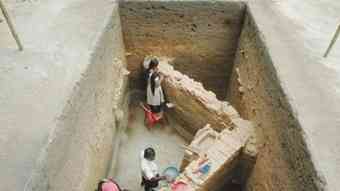Kerala is all set to offer its new tourism product to visitors — an ancient city near the port city of Kochi called Muziris which was a mystery for archaeologists and historians until recently.
 Some 23 monuments in and around the historic Kodungallur town have been identified as part of the Rs1.4 billion Muziris Heritage Project (MHP), the first phase of which will be launched later this month, Fisheries Minister S. Sharma said.
Some 23 monuments in and around the historic Kodungallur town have been identified as part of the Rs1.4 billion Muziris Heritage Project (MHP), the first phase of which will be launched later this month, Fisheries Minister S. Sharma said.
Researchers say this was once a buzzing trade center that attracted Romans, Greeks and Arabs as well as being a landing point for Judaism, Christianity, Islam and a number of world cultures in the southern Indian state.
Vessels came to this port from across the seas with gold and went back with black gold — the pepper that was abundant in ancient Kerala and various aromatic spices collected from its forests. The mystery was unraveled during excavations since 2004.
The British Academy this week honored the British Museum and the Kerala Council for Historical Research (KCHR) which were involved in the research with this year’s international partnership award that carries a grant of £30,000 for a joint research on “Indian Ocean Trade: The Archaeology of Technology” based on the Muziris findings.
Muziris was famous for more than 2,500 years and excavations have revealed fragments of imported Roman amphora, mainly used for transporting olive oil; also Yemeni and West Asian pottery and Indian wares have been found in Egypt.
The findings suggested that Muziris was a port of great international importance and that south India was involved in active trade with several civilizations of West Asia, the Near East and Europe through the port.
Researchers say Muziris could have been established as a city from before 1500BC and the port was already a bustling center of trade by 500 BC. Valmiki’s Ramayana, Vyasa’s Mahabharata, Sangam literature, the First Century Natural History of Pliny the Elder, the Second Century Geographia of Ptolemy, the Second Century Muziris Papyrus and the Fourth Century Tabula Peutingeriana refer to the city.
According to them, both the port and the city ceased to exist around the middle of the 13th century, possibly following an earthquake or the great flood of 1341 recorded in history, which caused the change of course of the Periyar River but no clear evidence has emerged as to when the port was first established.
Kerala Tourism authorities are optimistic about the tourism potential of the “lost and found” city which could attract archaeologists and historians as well as holidaymakers from Europe, Africa, East Asia and West Asia. The site could be preserved and function with prominence for cultural tourism in Kerala.
“This is another milestone in establishing Kerala as a quality tourist destination where responsible tourism is practiced in both letter and spirit,” Tourism Minister Kodiyeri Balakrishnan said.
The MHP aims at retrieving the historical heritage of the region and plans a combination of heritage management initiatives in its restoration, conservation and access to the public.
Some of the tourism-oriented highlights of the heritage site are circuit and timeline tours, culture tours, a series of museums, backwater cruises, visitors’ centres and a host of amenities that would combine well to promote infotainment.
St. Thomas, the apostle of Jesus Christ, and Muslim preachers are believed to have arrived in India through this port and it is here that India’s first church, Mar Thomas Church and the first mosque, Cheraman Juma Masjid, are located.
Author: Ashraf Padanna | Source: Arab News [August 18, 2010]